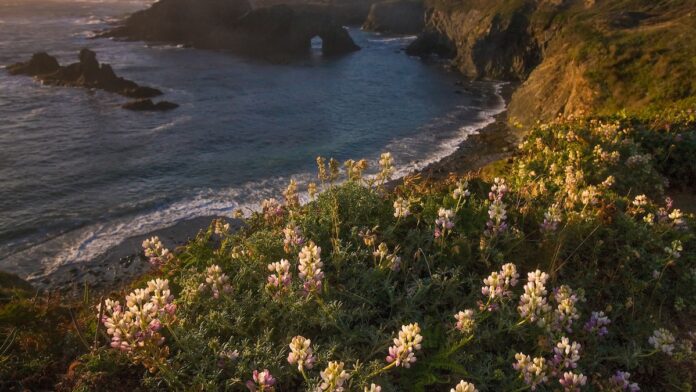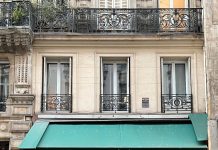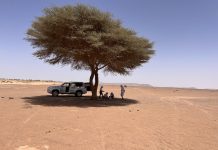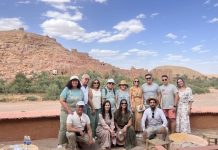The sun is hot, the vibe is cool, and it’s time to head to the beach. But, like many travelers, we seek more than soft sand and piña coladas. For us, a vacation destination should be welcoming, respectful, protective, and inclusive.
As queer globetrotters in our 40s, who have visited 50 countries across seven continents, we are constantly seeking new adventures and experiences beyond the usual hot spots. As co-authors of a forthcoming National Geographic guide for LGBTQ+ travelers, we look for destinations that embrace diversity and nourish community.
Having experienced moments where we feel limited by where and how we can travel, we believe that queer travelers—and all travelers for that matter—should have opportunities to go together and as they are. The goal of our research is to share our favorite inclusive destinations and encourage others to seek memorable experiences around the world.
(How destinations are helping LGBTQ+ visitors travel with pride.)
Here are eight coastal destinations—beaches, islands, and adventure sites in North America and the Caribbean—that offer a little something for every kind of traveler. Explore culture and history, take a hike, ride a bike, and more, and then end the day with your feet in the sand.
Mendocino County, California
Only about 150 miles north of San Francisco, this corner of California wine country—known for cliffside trails, stunning beaches, and redwood trees—has long been a welcoming region.
Mendocino Headlands State Park offers 350 acres of ocean bluffs, beaches, and wetlands along Big River. Don’t miss Fort Bragg’s famous glass beach, where you might be able to find a treasure in the form of refuse glass that has been smoothed over time and washed up on shore as colorful sea glass.
If you’re interested in towering redwoods, take the Skunk Train, less than a mile from Glass Beach, which has been operating since 1885. You’ll journey across trestle bridges and through tranquil meadows. Then you can unwind at the lesbian-owned Penny Royal Farms and Vineyards, a minimum-waste establishment with 23 acres of vineyards, cheese-making lessons, and a farmstead where every sheep has a name.
Mystic, Connecticut
An early adopter of equal rights legislation, Connecticut passed a 1991 gay-rights bill that prohibited discrimination based on sexual orientation in housing, employment, and credit—making it one of America’s most LGBTQ+-welcoming states.
The town of Mystic has a sparkling coastline that’s home to a seaport and aquarium, one of the Northeast’s largest organizations that rescues, rehabilitates, and releases sick or injured animals since 1975.
(Why LGBTQ+ tourists face tough decisions abroad.)
A 10-minute ride away, Bank Square Books has a good selection of queer titles. Just 30 minutes farther up the coast, Stonington Point is a small beach at the tip of a peninsula with astounding views of the sunset over the water. From it, you can visit the Old Lighthouse Museum, built in 1840, the first lighthouse museum in the U.S.
For additional outdoor fun, visit Pequot Woods Park, a 140-acre woodlands area for hiking and wildlife viewing. Or go to Tree Trail Adventures for scenic ziplining. For a charming overnight stay, check into the historic, lesbian-owned Mermaid Inn of Mystic, a Victorian home with Italianate architecture, in the heart of downtown.
San Juan Islands, Washington
Whether layered with thin ribbons of fog or shining blue, the gorgeous skies over the San Juan Islands are only matched by what you’ll find below: wooded parks with deep green Douglas firs and over 300 miles of low-lying coastline and charming seaside villages that feel untouched by time.
With an all-are-welcome vibe, it’s no wonder Seattleites love hopping flights or ferries to hike, bike, swim, and boat. Lopez Island has rolling farmlands and gentle topography that’s prime for cyclists. Each spring, Tour de Lopez offers a non-competitive cycling adventure through the bucolic landscape.
On Orcas Island, Moran State Park has more than 5,000 acres of terrain for biking, camping, hiking, swimming, and non-motorized boating. A four-hour trek to the summit of the 2,399-foot Mount Constitution, the islands’ highest point, offers a chance to see bald eagles and explore a stone observation tower constructed by the Civilian Conservation Corps in 1936. Here, you’ll find breathtaking panoramic views of Mount Baker, the North Cascades, and the glistening waters of the San Juan archipelago.
On San Juan Island, Friday Harbor is a cozy nook for shopping and dining, and Lime Kiln Point State Park is one of the world’s best places to spot orcas. Look for them swimming near shore or take a whale watching tour.
Please be respectful of copyright. Unauthorized use is prohibited.
Please be respectful of copyright. Unauthorized use is prohibited.
Left: In Washington State’s San Juan islands, kayaking is one of the best ways to explore the shore. Boating, fishing, and whale watching are also popular.
Photograph by Michael Hanson, Nat Geo Image Collection
Right: A ferry travels the waterways of the San Juan Islands in Washington State.
Photograph by Philip Schermeister, Nat Geo Image Collection
Nova Scotia, Canada
With Canada’s largest population of trans and non-binary people, Nova Scotia is a welcoming place for LGBTQ+ travelers. The province has a wide array of attractions for artists, nature, and history lovers.
The 100 Wild Islands, the largest coastal island wilderness area in Nova Scotia, is worth the visit, with 7,000 acres of gorgeous wilderness including coves of bright blue water, white sandy beaches, rainforests, and diverse wildlife.
In Halifax, the Bus Stop Theatre provides a space for artists—BIPOC female, trans and non-binary included—to showcase their work. Nearby New Brunswick’s Bay of Fundy is home to the world’s highest and lowest tides, best viewed from Hopewell Rocks.
(How digital tools are helping travelers avoid discrimination.)
On the Cabot Trail, a famous five-hour drive that loops around the island of Cape Breton on the eastern tip of Nova Scotia, you can look for whales at Pleasant Bay, hike in Cape in Breton Highlands National Park, and visit the Alexander Graham Bell National Historic Site.
On the South Shore, Lunenburg’s Old Town is a UNESCO World Heritage site with British colonial style homes, some dating back to the 18th century. For harbor views, stay at the LGBTQ-owned Pelham House Bed and Breakfast.
Mérida, Mexico
Near the western coast of the Yucatán Peninsula, Mérida is a vibrant, colorful, and LGBTQ-inclusive city—and one of the safest in North America. Mérida has a thriving queer community.
Along the historic Paseo de Montejo, an avenue with two miles of shops, historic buildings, and eateries, see the Monumento a la Patria (Monument to the Fatherland), a masterpiece of Colombian sculptor Rómulo Rozo Peña, which features more than 300 figures carved by hand. It’s especially spectacular at night when it’s lit up with different colors.
To soak up some nature, visit the region’s cenotes, natural limestone swimming holes with links to Mayan mythology. The towns of Sisal (a port where exports from Yucatán to Havana were first made in 1810) and Maní (known for its strong Mayan culture), are only an hour from Mérida and make a great side trip. They are known as “Pueblos Mágicos,” a designation given by Mexico’s Ministry of Tourism to places that have kept their original architecture, tradition, and culture, or have relevance to Mexico’s history.
Many of the cenotes in Mérida are believed to have been formed by the impact of an asteroid millions of years ago on the Yucatán Peninsula. These cenotes form a ring around the the Chicxulub Crater.
Photograph by Omar Montero, EyeEm / Getty Images
Please be respectful of copyright. Unauthorized use is prohibited.
Curaçao, Dutch Antilles
With a motto of “biba i laga biba” (live and let live), the island of Curaçao is famous for its hospitality and is the perfect place to unwind, explore Dutch-style neighborhoods, and sample local cuisine.
The island hosts an annual Pride festival in late September and its beaches, such as Playa Lagun (great for snorkeling) and Grote Knip (famous for its electric blue water), are coastal highlights.
In the capital city of Willemstad, a UNESCO World Heritage site, there are Dutch-style buildings shaded in vibrant pastels, a striking natural harbor, lively restaurants for sampling Dutch Bitterballen and Antillean beef stew, and the Kura Hulanda Museum. An anthropological museum housed in a series of 19th-century buildings, it details the chilling history of the African slave trade, including displays depicting how Africans were forcefully relocated to the Caribbean and Americas, and the brutal conditions enslaved people had to endure. The museum is home to a collection of African and Mesopotamian art and artifacts detailing how diverse cultures influenced Curaçao’s society.
Nature lovers can take in Curaçao’s beauty at Christoffelpark, the island’s largest national park, which is great for hiking, birdwatching, and scenic drives. At nearby Shete Boka National Park, watch massive waves crash against a dramatic volcanic landscape in a spectacular fashion.
St. Petersburg, Florida
Florida’s beaches are a big draw, but St. Pete, as the locals call it, offers so much more. From street and museum art to a stroll in botanical paradise, St. Pete has a thriving LGBTQ+ community with several queer-owned businesses.
Try Lingr, a restaurant serving creative dishes such as hamachi crudo and soy sauce cured salmon, Let It Be Ice Cream for homemade sweet treats, and Tombolo Books, offering reads from around the world, including LGBTQ+ books for young readers. The store also hosts special events with queer writers.
St. Pete is home to one of Florida’s largest Pride celebrations (in June) and colorful murals that celebrate inclusivity. Don’t miss the Pride Street Mural, featuring 11 stripes to include members of the LGBTQ+ community and people of color, and the Black Lives Matter Mural, painted by 16 local artists.
For art lovers, the Dali Museum houses an outstanding collection of Salvador Dali’s oil paintings, drawings, and sculptures; and the Museum of Fine Arts is home to 20,000 Greek, Roman, African, and Asian works. For outdoor fun, the 1,136-acre Fort DeSoto Park has serene nature trails and spots to cool off, and the 100-year-old Sunken Gardens is a biodiverse oasis of some 50,000 plants and tropical flowers.
As the 15th state to legalize same-sex marriage in 2013, Hawaii has long been an inclusive destination. While Oahu (home to Honolulu, Pearl Harbor, and Waikiki Beach) attracts the most visitors, the Big Island is popular with LGBTQ+ travelers seeking adventure, natural beauty, and cultural experiences in a more relaxed environment.
The areas of Kona and Hilo have several LGBTQ+-owned accommodations such as the Kane Plantation Guest House, located on a 27-acre avocado farm with sweeping views of the Kona Coast; and the Hilo Bay Hale Bed and Breakfast, a historic building from 1914 that was saved from demolition in 2008 and restored as an inn. It features relaxing gardens, soaring bamboo, and—for Golden Girls fans—lanais.
The Big Island is known for its biodiversity and vast ecosystems, including volcanoes spewing molten lava, rainforests, and beaches such as Papakōlea—a rare green sand beach (there are only three others in the world) colored by olivine crystals.
While visiting this welcoming isle, don’t miss visiting Volcanoes National Park, touring the Kona Coffee Living History Farm, snorkeling at Hāpuna Beach State Park, learning more about the powerful forces of nature at the Pacific Tsunami Museum, night diving with manta rays, immersing yourself in Hawaii’s early history and culture at Pu’uhonua O Honaunau National Historic Park (meaning “last place of refuge,” the area was a haven for law breakers in ancient Hawaiian society), and stargazing at Mauna Kea, a sacred site that’s also the world’s tallest mountain when measured from the ocean floor.
Amy B. Scher is an author based in New York City. You can find her on Twitter.
Mark Jason Williams is a playwright and travel writer. You can find him on Twitter.










